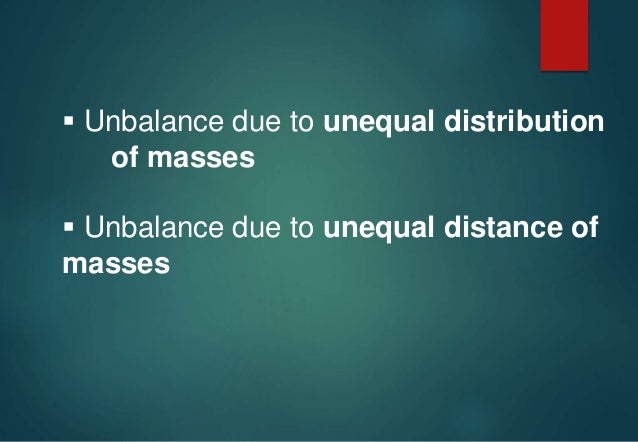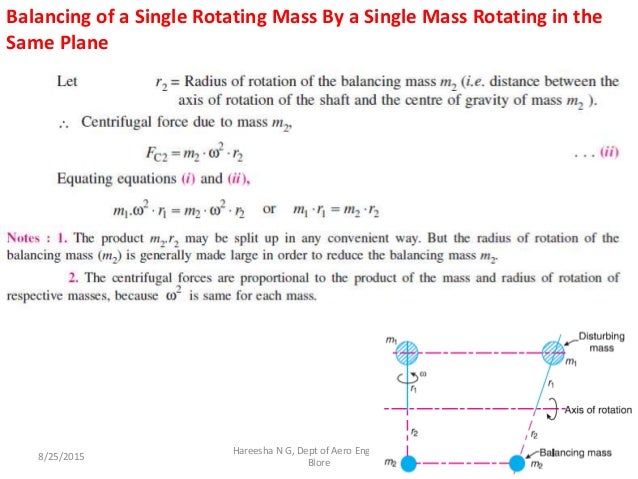
- Balancing Of Rotating Masses
- Balancing Of Rotating Masses Problems
- Balancing Of Rotating Masses
- Theory Of Balancing Of Rotating Masses
YYQ-100A balancing of rotating masses with good price
Lab Report 1. They are mainly due to uneven distribution of mass either of the material itself or the whole assembly. Other than that, the shape of the rotating parts can also affect the balancing. An unbalanced rotating machinery will create a lot of consequences such as shorter lifespan, energy consumption and failure of parts.
1,high precision
2,high quality
3,high efficiency
4,low failure rate
Specifications
Balancing of rotating parts is necessary for every engine, only in high speed engines it becomes very important. The force exerted by the rotating parts is proportional to the square of the rotational speed, omega. Balancing of rotating parts is a complex and fascinating subject to discuss but we can't answer your particular questions without knowing more about the problem. Please describe - or better sketch - the shaft that this problem relates to and tell us anything relevant about the purpose of the shaft and the running speeds. Is called balancing of rotating masses. The following cases are important from the subject point of view: 1. Balancing of a single rotating mass by a single mass rotating in the same plane. Balancing of a single rotating mass by two masses rotating in different planes. Balancing of different masses rotating in the same plane. MECH2210 Experiment 2: Balancing of Rotating Masses. Three masses m1, m2 and m3 are rotating in three planes at radii r1 to r3 at angles θ to a reference plane as shown in Figure 1. In general, there will be a resultant unbalanced force and couple. Balancing of Rotating Masses • The following cases are important from the subject point of view: 1. Balancing of a single rotating mass by a single mass rotating in the same plane. Balancing of a single rotating mass by two masses rotating in different planes. Balancing of different masses rotating in the same plane. Balancing of Rotating Masses • Whenever a certain mass is attached to a rotating shaft, it exerts some centrifugal force, whose effect is to bend the shaft and to produce vibrations in it. • In order to prevent the effect of centrifugal force, another mass is attached to the opposite side of the shaft, at such a position so as to balance the effect of the centrifugal force of the first mass.
Balancing Machine for Turbocharger, Turbine,Compressor,Impeller,Rotor
1,high precision 2,high quality 3,high efficiency 4CE
Hard Bearing Balancing Machine
Apply for all kinds of turbocharger rotors
Electro-dynamic vibration force pickup, highly measuring precision
Range of Application
This balancing machine is designed for balancing all kinds of turbocharger rotors and other rotors such as kinds of good-sized and medium-sized turbocharger rotor,turbocharger impellers,turbocharger turbines,turbocharger compressors,motors, textile machinery, crankshaft,roller,fans,shaft according to demanding of our customers.
Design
Its specialty that there are two bearing pedestals selection and mostly satisfied variety rotors , etc .. Driven by belt,it is simple to load and unload,quick to start and with high precision and low failure rate.
Production Parameters
Technical data at a glance | YYQ-100A |
Mass scope of workpiece kg | 2-100 |
Biggest diameter workpiece mm | 900 |
Two span of supports mm | 80-1000 |
With a diameter circle in drag mm | 30-300 |
Trunnion support mm | 10-90 |
Balancing speed r/min | 300-2500 |
Min achievable residual unbalance amount | ≤0.5gmm/kg |
Unbalance reduction ratio% | ≥90% |
Motor power | 1.5KW |
mode of speed regulation | Variable frequency speed regulation |
Transmission model | Circle with |
YYQ-100A balancing of rotating masses with good price picture
YYQ-100A series balancer
YYQ-100A balancer pictures
YYQ-100A balancing machine workpieces
Contact:
Bali
Skype: bali-wang
Tel: 0086-15953129330
Open 24 hours
The balancing of rotating bodies is important to avoid vibration. In heavy industrial machines such as gas turbines and electric generators, vibration can cause catastrophic failure, as well as noise and discomfort. In the case of a narrow wheel, balancing simply involves moving the center of gravity to the centre of rotation. For a system to be in complete balance both force and couple polygons should be closed.in order to prevent the effect of centrifugal force.

Static balance[edit]
Static balance occurs when the centre of gravity of an object is on the axis of rotation.[1] The object can therefore remain stationary, with the axis horizontal, without the application of any braking force. It has no tendency to rotate due to the force of gravity. This is seen in bike wheels where the reflective plate is placed opposite the valve to distribute the centre of mass to the centre of the wheel. Other examples are grindstones, discs or car wheels.
Dynamic balance[edit]
A rotating system of mass is in dynamic balance when the rotation does not produce any resultant centrifugal force or couple. The system rotates without requiring the application of any external force or couple, other than that required to support its weight. If a system is initially unbalanced, to avoid the stress upon the bearings caused by the centrifugal couple, counterbalancing weights must be added.This is seen when a bicycle wheel gets buckled. The wheel will not rotate itself when stationary due to gravity as it is still statically balanced, but will not rotate smoothly as the centre of mass is to the side of the centre bearing. The spokes on a bike wheel need to be tuned in order to stop this and keep the wheel operating as efficiently as possible.[2]
Unbalanced systems[edit]

When an unbalanced system is rotating, periodic linear and/or torsional forces are generated which are perpendicular to the axis of rotation. The periodic nature of these forces is commonly experienced as vibration. These off-axis vibration forces may exceed the design limits of individual machine elements, reducing the service life of these parts. For instance, a bearing may be subjected to perpendicular torsion forces that would not occur in a nominally balanced system, or the instantaneous linear forces may exceed the limits of the bearing. Such excessive forces will cause failure in bearings in short time periods. Shafts with unbalanced masses can be bent by the forces and experience fatigue failure.
Balancing Of Rotating Masses
Under conditions where rotating speed is very high even though the mass is low, as in gas turbines or jet engines, or under conditions where rotating speed is low but the mass is high, as in ship propellers, balance of the rotating system should be highly considered, because it may generate large vibrations and cause failure of the whole system.
Balancing Of Rotating Masses Problems
References[edit]
Balancing Of Rotating Masses
- ^Gaetano Lanza (2009). Dynamics of Machinery (Reprint of 1911 ed.). BiblioBazaar. p. 112. ISBN978-1-103-19721-7.
- ^Owen, David. 'How to Balance a Bicycle Wheel'.